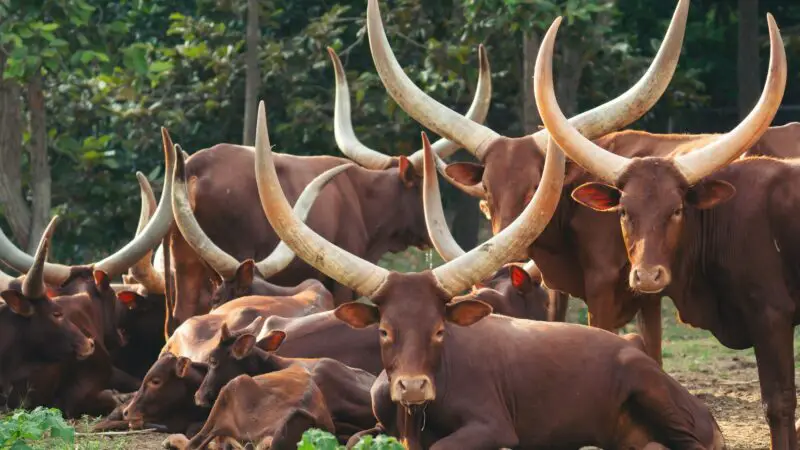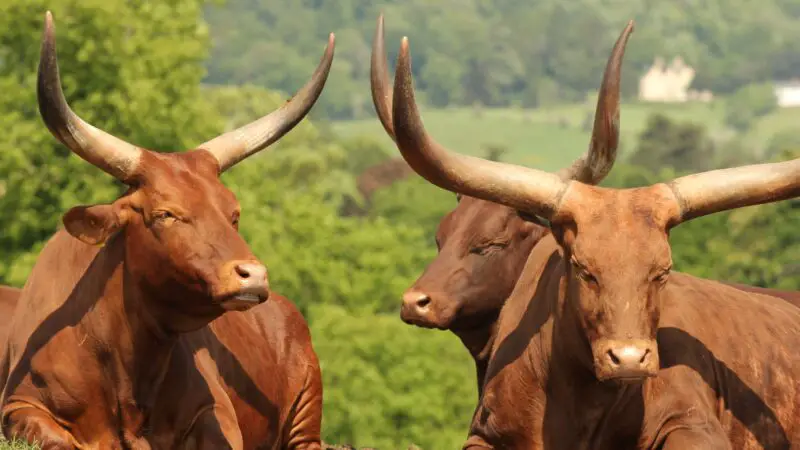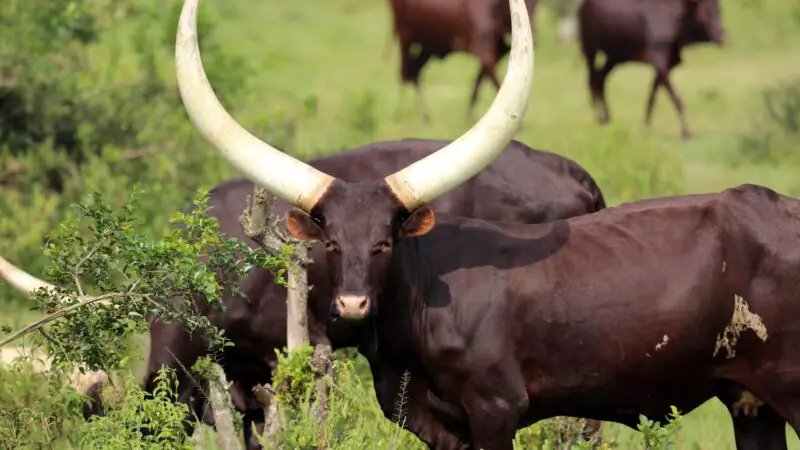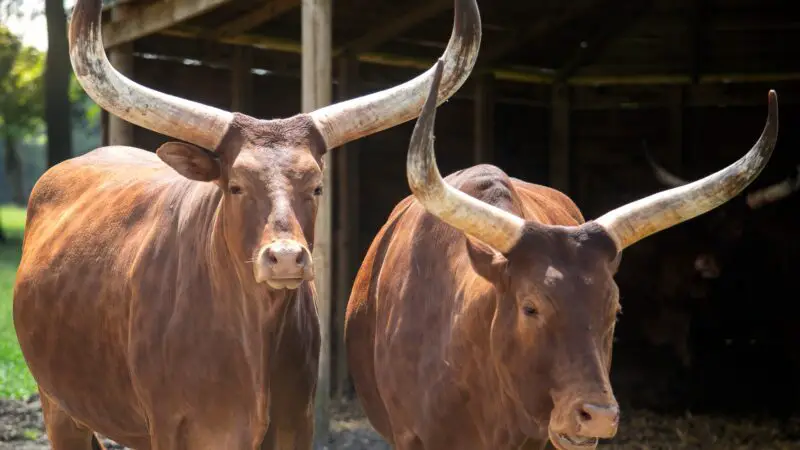Raising cattle may prove to be a satisfying enterprise, whether you’re growing them for beef or milk production. Selecting the right breed for you is an important step in starting your own cattle farm. One interesting and unusual-looking breed is the Ankole Watusi Cattle.
Ankole Watusi cattle is a heritage cattle, specifically a variety of the Sanga cattle, originating from Africa. They are known for their unusually large and lengthy horns as well as their good beef quality, which has low amounts of fat and cholesterol, and milk, which has high butterfat content.
To know more about Ankole Watusi cattle, their physical appearance, distinctive characteristics, how to take care of them, and other relevant information, read further this article!
Ankole Watusi Cattle History

The Sanga cattle family from Africa became the base stock of many indigenous breeds among these were the Ankole cattle, which is the Nkole tribe’s variety of the Sanga cattle in Uganda, and the Watusi from the Tutsi tribe in Burundi and Rwanda. These strains were later combined when they were exported, ultimately becoming the Ankole-Watusi cattle.
Due to their striking appearance, the Ankole-Watusi cattle were exported to European zoos sometime between the late 1800s to early 1900s. Game parks and zoos in Sweden, Germany, and England became the primary breeders of these cattle. In the 1920s and 1930s, American zoos began importing cattle.
In January 1983, the Ankole Watusi International Registry was formed, which consisted of North Americans that had been raising cattle since 1978. The members have different priorities for the Ankole Watusi cattle, with some prioritizing the prevention of the breed’s extinction, cross-breeding, or emphasizing its commercial qualities.
Since the adoption of a breed standard in 1989 by the registry, animal scientists have taken the breed seriously instead of deeming it as merely a curiosity. Meat studies have been done in recent years to determine the different characteristics of Ankole-Watusi meat.
What Is So Special About Ankole Cattle?

Ankole Watusi cattle are known for their unusual horns, which are large at the base, long, and symmetrical in shape. They also have good beef, which has low amounts of fat and cholesterol compared to other commercial types of beef, as well as milk with high butterfat content.
What Is a Ankole Watusi Cattle?

What Do Ankole Watusi Cattle Look Like?
A medium-sized, elegant, and graceful-looking cattle with a sloping rump, straight topline, and may have a neck hump. They are either solid in color, spotted, or speckled, but most cattle are predominantly dark red, but some may be black or dun.
They also have noticeably long and symmetrical horns, which have a large base. African breeders desire lyre- or crescent-shaped horns, but American breeders prefer laterally-shaped horns.
The Guinness World Records lists a steer and a bull named Lurch and CT Woodie to have the largest horn circumferences at 37.5 and 40.7 inches, respectively.
How Long Does an Ankole Watusi Cattle Live?
Ankole Watusi cattle can live up to 20 years in their native habitat and up to 26 years in captivity.
What Do Ankole Watusi Cattle Eat?
In their native habitat, they eat savannah grasses and leaves, but they are also able to feed on other pasture plants and forages. They are also fed with grains such as barley, oats, and corn, as well as hay and silage.
How Big Do Ankole Watusi Cattle Grow?
Ankole Watusi cattle grow up to a height of 6.5 feet at the shoulders.
Are Ankole Watusi Cattle a Heavy Breed?
Ankole Watusi cattle are relatively lightweight compared to other breeds, with mature females weighing 900 to 1,200 pounds and mature males weighing 1,000 to 1,600 pounds.
What Is Ankole Watusi Cattle Known For?
Ankole Watusi cattle are primarily raised for both lean beef quality, high butterfat milk (around 10%), and excellent maternal abilities. Some farmers even use this breed for crossbreeding with other varieties to boost butterfat content in their respective herds.
Where Do Ankole Watusi Cattle Originate?
They originate from Eastern Africa, specifically, they are a combination of the Ankole cattle from Uganda and the Watusi from Burundi and Rwanda.
What Are the Distinct Characteristics of an Ankole Watusi Cattle?
Ankole Watusi cattle can tolerate temperatures anywhere between 20°F to 120°F since they are naturally adapted to the African climate. Their unique horns are also able to circulate cooled blood throughout their entire bodies, allowing body heat to disperse.
Ankole Watusi Cattle Temperament
They are a gentle and docile breed, despite their somewhat intimidating appearance. They also have great social instincts as they huddle close together when they sense predators. However, when bulls are feeling particularly aggressive, they may use their horns to butt humans and other animals in their vicinity.
Is Ankole Watusi Cattle Meat Good?

Ankole Watusi lean beef is known to have a very low-fat content and lower amounts of cholesterol compared to other commercial beef.
How Much Does an Ankole Watusi Cattle Cost?
Adult Ankole Watusi cattle cost around $1,500 to $5,500, depending on age and sex.
Tips in Taking Care of Ankole Watusi Cattle
Housing
Although cattle have minimal housing requirements, Ankole Watusi cattle would still need sufficient pasture and/or dry lot space as well as protection from inclement weather conditions such as harsh wind and rain.
Here are some recommended housing structures:
- Open-sided, single-sloped roof shed. This is the most typical housing structure and is suitable for any type of cattle. It is also inexpensive and easy to build. They should face towards the south for the winter sun.
- Open-sided, clear-span pole shed. If you need more space for equipment, this is the most ideal choice. The gable end of this shed should be open so that any rain or snow will not fall on the open side of the building.
- Former dairy barns. Many dairy farmers have abandoned their respective dairy barns either due to retirement or dispersal. These structures can be renovated to provide more lighting and ventilation for the cattle as well as removing manure to ensure cleanliness.
- Hoop barns. These structures are similar to greenhouses but may not provide sufficient protection from the heat during the summer months.
Nutrition
Cattle weighing 650 pounds or less should be fed a growing ration initially, which provides additional hay or forage for the livestock. For cattle weighing 700 pounds or more, their ration should consist of 11% crude protein, which is mainly composed of grain, roughage, and protein sources such as soybeans.
An example of cattle feed is corn, soybeans, corn silage, orchardgrass hay, limestone, and vitamins and minerals (in the form of supplements).
Feeders
You can choose among feed bunks (which are economical and practical), portable hay feeders (to provide supplementary hay feeding in a feedlot, field, or loose housing barn), and bale feed racks (if you want to reduce the amount of hay wastage) as long as they can prevent the cattle from eating off the ground and contract any diseases and infections.
Waterers
You should be able to supply enough water for your cattle and regularly replace them to ensure that what they drink is always fresh and clean. Buckets, troughs, or automatic watering systems can work.
Pasture Systems
Cattle, especially beef cattle, graze pastures throughout the spring, summer, and fall seasons. Due to this, owners must maintain pasture height to optimize forage utilization. To do this, pasture should be subdivided according to grazing time. Cattle should graze down one section for 4 to 5 days before moving to a new section.
Water should also be available and accessible in pastures. To keep the livestock safe and sound inside the pasture, construct a perimeter fence, preferably with electrified wires.
Health Management
This involves tagging, deworming, vaccinating, hoof trimming, and castrating your cattle. Some equipment you need includes tags, tagging pliers, a drench syringe or gun, syringes, needles, band expander tools, and elastrator bands.
Is It Expensive to Raise Ankole Watusi Cattle?

Ankole Watusi cattle are expensive to raise. Generally, raising cattle would cost around $500 to $1,000 per cattle, excluding the cost of the cattle itself. This includes expenses such as pasture maintenance, feed, vitamin and mineral supplements, veterinarian visits, breeding, marketing, machinery, and other facilities, trucking, depreciation, and interest.
How Much Space Does an Ankole Watusi Cattle Need?
| Area | Calves (400 to 800 pounds) | Finishing Cattle (800 to 1,200 pounds) |
| Barns | 12 to 20 feet | 18 to 35 feet |
| Pasture | 0.5 to 1.5 acres | 1 to 2 acres |
| Feeder space | 18 to 22 inches | 22 to 26 inches |
Related Questions
Can You Eat Watusi Cattle?
You can eat their meat.
How Much Is an Ankole Cow?
An adult Ankole cow can cost around $1,000 since they are rare but in high demand.
Where Can I Find Ankole Cows?
Ankole cows are generally found near Lake Tanganyika to Lake Mobutu in Eastern Africa. However, the 3 main strains are distributed across Northern and Southern Kivu as well as in Burundi, Africa.
How Much Do Ankole Cattle Horns Weigh?
Ankole Cattle horns weigh around 900 to 1,600 pounds, depending on sex and age.
Are Ankole Cattle Horns Hollow?
Ankole horns are hollow despite their size, they are actually lightweight because they are hollow inside.
